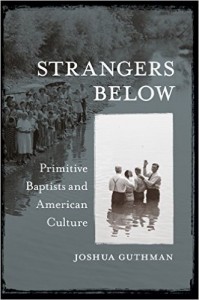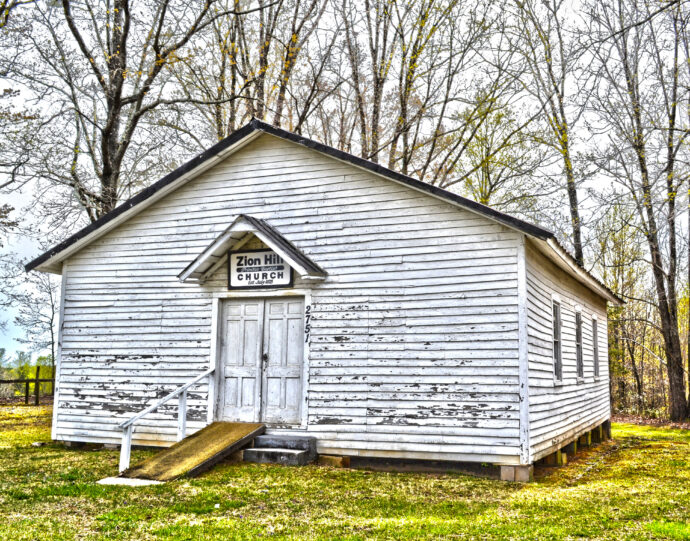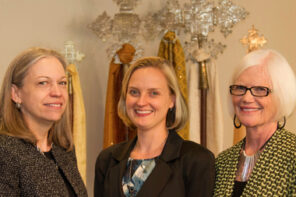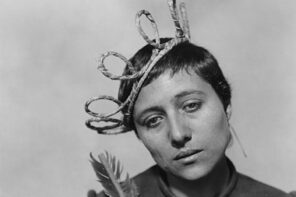What inspired you to write Strangers Below: Primitive Baptists and American Culture?
I heard the Primitives before I knew anything about them. It was their singing. There was a keening voice begging God for deliverance, a voice answered in long sonorous swells by other voices, all of them unspooling a modal melody, and the hymn itself sung so slowly as to melt its text into an incantatory strain that sounded to me like people calling up spirits. It struck me dead. I had never heard anything like it. It was beautiful. Those sounds possessed me and puzzled me and would not let me go.
Then, when I started learning about the Primitives just to satisfy my curiosity, I only became more fascinated and confused. I learned that they were Calvinists, that they opposed missionary efforts, thought revivals were a kind of sinister emotional theater, and that they had split acrimoniously from their fellow Baptists early in the nineteenth century. These bare facts only raised more questions. Evangelicals opposed to missions? Predestinarian Calvinists in the come-to-Jesus South? Doubters planted among the legions of the assured? And then that there were, by the 1830s, tens of thousands of them crowding churches from Florida’s swamplands to Illinois’s prairie? Tell me more, I thought.

Strangers Below: Primitive Baptists and American Culture
Joshua Guthman
UNC Press
(September 28, 2015)
What’s the most important take-home message for readers?
That the Primitive Baptists’ story is an unlikely one, but a vital one, an American one. Beneath that message are three stories.
The first one prowls the early decades of the nineteenth century when the Primitives’ rise marked a crisis within the bounds of American evangelicalism. The Primitives’ peculiar status as both children and adversaries of evangelicalism allows us to rethink the origins of the Bible Belt as a fight, not between the churched and the unchurched or between insurgent evangelicals and a curdled Anglican establishment, but between different factions of evangelicals over the future of American Protestantism. Primitives were Calvinists, they were doubters, and they belonged to a community of believers engaged in constant anguished discussion about their own minds.
When Primitive Baptists sang the words of their old hymn—”I am a stranger here below / and what I am ’tis hard to know”—they sang from personal experience. But the emotional uncertainty that colored Primitive Baptist selfhood motivated believers rather than paralyzed them. It propelled them towards a community of like-minded souls, and it stirred those souls to action as a more ardent brand of evangelical Protestantism crowded church pews. So this first story ultimately shows that antebellum fights over the fate of American Protestantism were catalyzed not so much by organized structures of denomination, social class, and ideology, but rather by believers’ unpredictable emotional experiences.
The second story unfolds in the late-nineteenth century when African-American Primitives reconstructed Calvinism’s withered frame to build an education movement grounded in what they described as their “hardshell” Calvinist identity: rugged yet flexible, durable yet capable of adaptation. This is a tale that has entirely escaped notice even though its burdens and aspirations tell us something new about African Americans, Calvinism’s complex fate, and the religious reconstruction of the post-Civil War South.
It has long been a given among historians of religion in the South that Calvinism had little, if any, purchase among the enslaved or their descendants, that the doctrines of predestination were invariably arms of the status quo, and that a sin-obsessed Calvinism was simply inimical to the emancipationist energies coursing through black America in the decades after the Civil War. How can I put this gently? The black Primitives I write about complicate all these hoary assumptions. Their black Calvinism was at once organizationally dynamic and theologically orthodox. Their story is a crucial and until-now overlooked chapter in the reinvention of black religious life during the late-nineteenth and early-twentieth centuries.
The third and final story is a ghost story. It’s about the strange diffusion of the Primitives’ sensibility in modern American roots music. For me, it all started while I was listening to the radio in my Volkswagen. This was in early 2002. I heard the bluegrass legend Ralph Stanley chanting out “O Death,” a chilling a cappella deathbed plea that had become famous as part of the soundtrack to the movie O Brother, Where Art Thou? Hearing that song on country music radio will make the mind turn. I wasn’t the only one arrested by Stanley’s performance. It won Stanley a 2002 Grammy Award for best male country vocal and, last time I checked, it had sold a stupefying total of more than nine million copies. Fans and critics alike rhapsodized about Stanley’s voice. (They still do.) It was haunting and ghostly and otherworldy, they said over and over again. And, above all, it was real.
I knew that something similar, though on a much smaller scale, had happened a generation earlier when an until-then unknown singer from eastern Kentucky, Roscoe Holcomb, made a splash among folk revival audiences. Holcomb’s music had stunned me when I first heard it in the late-1990s while ringing people up at the register of a Los Angeles record store, but I can’t say that Holcomb had been much on my mind until that evening, several years later, when something in Stanley’s quavering rendition of “O Death” sent me scrambling back to him—to his elastic and unaccompanied “I am a Man of Constant Sorrow,” a song that shared its anguish and slender hope both with “O Death” and with the experiences of the old Primitive Baptists about whom I was just beginning to learn.
The connection I sensed that evening is this third and final story’s conceit: Holcomb and Stanley’s popularity marked the eruption into American popular culture—on LPs, in movies, and through a car stereo’s speakers—of a Calvinist feeling, a lonesome sound, that had, by all rights, been buried at least a century before.
Is there anything you had to leave out?
Oh my, yes! But, you know, “had to” is a funny thing. No one demanded that I excise huge portions of the manuscript. It’s just that I had tons of “information,” and I tried to do the right thing by all of it, which is just to say that I thought I could tell a better story by streamlining the shape of the book. The result is a series of essays that move chronologically instead of a lumbering step-by-step history.
What are some of the biggest misconceptions about your topic?
That “primitive” is somehow a derogatory term, that it means these Baptists are somehow backwards or ignorant, when in truth the appellation signals the Primitives’ direct connection to the first church, the primary church, the apostolic church that surrounded Jesus.
Did you have a specific audience in mind when writing?
The historian Daniel Calhoun once wrote: “There come times when an inquirer asks not What can we prove? but What if it should be true that all these threads do hang together?” I wrote for readers who think like that, readers who ask lots of questions, readers who cultivate puzzlement, readers who will come along with me as I pose possible answers.
Are you hoping to just inform readers? Entertain them? Piss them off?
I want to bring people closer to the Primitives. I hope that I was able to capture their experiences, their moods, their spiritual crises, their determination. And then, if the book is able to forge that kind of connection between present-day readers and the deep past, I hope readers will be able to see the emergence of the Bible Belt and the fate of American Calvinism in new and different ways.
What alternative title would you give the book?
I originally wanted to go with American Primitives full stop. No subtitle. I thought it was clean and it distilled the argument down to two words. Other folks found it cryptic and preposterous. I eventually agreed with them. Kinda.
How do you feel about the cover?
I love it. The designers at UNC Press are fantastic. They took a great photograph by the FSA photographer Marion Post Wolcott and—I hope it’s okay to say this—made it even better. The cropping, the hazy filter, the “spotlight” on the folks in the river, the typography: all of these elements masterfully evoke the book’s title.
Is there a book out there you wish you had written? Which one? Why?
Do As I Lay Dying and The Transit of Venus count? If it’s histories we’re talking about, then anything by John Demos and almost anything by Edmund Morgan, Carlo Ginzburg, and Lyndal Roper.
What’s your next book?
It’s a story. Or really a series of linked stories. Each is a microhistory of a kind. They all have to do in some way with the subterranean worlds seething beneath what we still glibly call the Second Great Awakening.





